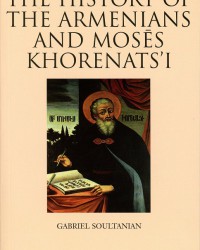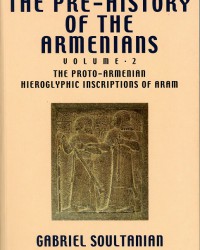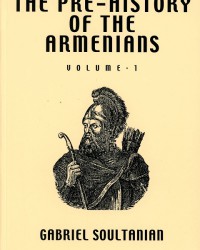 |
The history of the Armenians and Mosès Khorenats'i
Editeur : Bennett & Bloom
Année : 2012
Imprimeur/Fabricant : Newton Printing, London
Description : 14 x 21 cm, 280 pages, couverture illustrée en couleurs, index
Collection : History: Europ, Caucasus and Middle East / Historiography
ISBN : 9781898948131
'This man created from seemingly nothing a complete history, employed an honest attitude at all times and never sought to mislead the reader. I cannot but admire his genius, and it is my hope the reader of this book will see Moses' History as a remarkable product of fifth-century thought and methods.' Moses Khorenats'i, also known as Moses of Chorene, is among the most problematic historians of early times. Known as the Father of Armenian History, he was a skilled philosopher and rhetorician whose History has been used as a textbook for many centuries. Constant editing and alteration of his work, however, have created difficulties in identifying the original work and, as a result, has cast obscurity on Moses' methods and his sources. Using extensive research into the pre-history of the Armenians and the seventh-century History of Bishop Sebeos, Gabriel Soultanian sheds light on the obscure areas of the History and its creator. Combined with the Assyro-Babylonian sources, he confirms the majority of the names, ancient sayings, demotic tales and events that Moses records and throws light on many other frustrating or ill-understood problems. In the process he also solves the problem of dating Khorenatsi and his work, a hitherto controversial subject not helped by conflicting and unfounded theories expounded by scholars previously on the subject. |
 |
The history of Bishop Sebéos
Editeur : Bennett & Bloom
Année : 2007
Imprimeur/Fabricant : Newton Printing, London
Description : 14 x 21 cm, 120 pages, couverture illustrée en couleurs, index
ISBN : 9781898948926
This redefining of a key narrative of the history of Armenia is a detective story that is as remarkable as it is controversial. It sets out to prove conclusively that the History of Sebeos, written in the seventh century, is the inspired work of a single author. Sebeos was a bishop of the Armenian House of the Bagratunis. His History is the only surviving work of its type from this period. It describes events in the Middle East spanning a crucial period of two centuries - from the late fifth century to AD 661, when the Armenians found themselves caught between the warring empires of Persia and Byzantium. In many ways, the work can be considered as a continuation of the History of Lazar P'arpets'i, which was composed at the beginning of the sixth century. Considered to be problematic until now, the first five chapters of the work were written on the order of Sebeos's unnamed patron to compile a complete history of the Armenian nation up to his time. Scholars declared this to be an imperfect text that was not only based on unreliable sources but also the product of more than one writer.Through historical and linguistic techniques, Gabriel Soultanian identifies then solves a string of puzzles in the text that previous studies have failed to explain. Crucially, he demonstrates that any irregularities in the text result from quirks in Sebeos's personality or the desire to follow his patron's agenda. Soultanian's masterful analysis is a rediscovery of the true voice of the History of Bishop Sebeos, and a long awaited correction of Armenia's historical record. |
 |
The pre-history of the Armenians - Volume 2
Editeur : Bennett & Bloom
Année : 2004
Imprimeur/Fabricant : Newton Printing, London
Description : 14 x 21 cm, 432 pages, couverture illustrée, index
ISBN : 9781898948278
Dating back nearly three thousand years, the carved hieroglyphic inscriptions of southeast Anatolia have been ascribed erroneously to the ancient Luwian language. This new work provides indisputable evidence not only that these inscriptions were written in the purest form of the Armenian language but also that Armenians had their own unbroken tradition of writing long before Mesrop Mashtots invented the modern Armenian alphabet around 404 AD. In this companion to The Pre-History of the Armenians Volume 1, new techniques are used to provide a comprehensive translation of 40 key inscriptions. Each translated phrase is followed by its actual proto-Armenian counterpart in parenthesis, which enables an instant link between words and symbols. The extensive Vocabulary and Usage section provides definitions and cites examples in other inscriptions. Appendices provide exhaustive lists and sound charts of the ideograms and logograms in their illustrated forms. |
 |
The pre-history of the Armenians - Volume 1
Editeur : Bennett & Bloom
Année : 2003
Imprimeur/Fabricant : Newton Printing, London
Description : 14 x 21 cm, 224 pages, couverture illustrée, index
ISBN : 9781898948247
This pre-history of the Armenian or Hay people is unique in covering the 600-year period from the end of the 13th century to the beginning of the 6th century BC. It traces the various Hay migrations from the Balkans to the original places of settlement in Anatolia. There they developed a highly advanced script known as the Neo-Hittite hieroglyphics, originating in the early 10th century BC. The Hays finally entered Urartu itself, where they adopted their Armenian identity as we recognise it today and laid the foundations of their nation. This study fills a surprising scholarly gap in Armenian pre-history — essential to a complete understanding of the Middle East from 1000 BC onwards. Previous historians concerned with the origins of Armenia and its people in Anatolia have been content to present this history as a continuation of that of ancient Urartu, yet the changes of name and identity of its inhabitants indicate that these origins lie elsewhere. |




